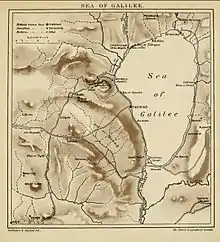Woes to the unrepentant cities
Matthew's gospel and Luke's gospel record Jesus' message of woe to the unrepentant cities of Chorazin, Bethsaida and Capernaum, located around the northern shore of the Sea of Galilee, for their refusal to repent.[1]

The text in Matthew's gospel states:
Then Jesus began to criticize openly the cities in which he had done many of his miracles, because they did not repent. "Woe to you, Chorazin! Woe to you, Bethsaida! If the miracles done in you had been done in Tyre and Sidon, they would have repented long ago in sackcloth and ashes. But I tell you, it will be more bearable for Tyre and Sidon on the day of judgment than for you! And you, Capernaum, will you be exalted to heaven? No, you will be thrown down to Hades! For if the miracles done among you had been done in Sodom, it would have continued to this day. But I tell you, it will be more bearable for the region of Sodom on the day of judgment than for you!"
The three cities mentioned lay just north of the Sea of Galilee. Chorazin is not otherwise mentioned in the Gospels. Bethsaida is where Philip, Andrew, and Peter were from,[2] and where Jesus healed a blind man.[3] Capernaum, however, is mentioned many times in the Gospels and was the site of many of Jesus' healings and miracles, serving for a time as the center of his public ministry.
Tyre and Sidon were cities against which the prophets of the Old Testament had pronounced God's judgment.[4] Sodom was infamous as the city which, according to the Book of Genesis, God had spectacularly destroyed for its wickedness in the time of Abraham.[5]
In essence, then, Jesus is contrasting three Jewish towns where he has performed many signs, with three Gentile cities known for such extraordinary wickedness as to deserve God's destruction, saying that on the Day of Judgment the former will be judged more harshly, because of their greater unwillingness to repent.[6]
These cities are associated with the Antichrist in medieval sources. The Apocalypse of Pseudo-Methodius, commenting on the above Gospel passage, states that the Antichrist "will be conceived in Chorazin, be born in Bethsaida, and begin to rule in Capernaum."[7]
Commentary
Cornelius a Lapide comments on the verse "Truly, I say unto you, it shall be more tolerable..." writing that the citizens of Tyre and Sidon will be punished because of their wickednesses, but that the Galilæans will be punished more severely: "1. Because ye had greater knowledge of God’s law, and virtue. 2. Because ye have often heard Me preaching and exhorting to repentance, and have beheld Me doing many miracles, none of which things the Tyrians have either seen or heard." He draws the further moral point that Christians will be punished more severely in the day of judgment than Jews; the Roman citizens, than Indians; priests, nuns and monks, than laymen; if the former lived sinful lives, because "they have received greater degrees of grace and knowledge from God, and would not make use of them, but abused them to their own greater damnation."[8]
See also
- Woes of the Pharisees – a list of criticisms by Jesus against scribes and Pharisees
- The four woes of Jesus
References
- Matthew 11:20–24; Luke 10:12–16
- John 1:44, 12:21
- Mark 8:22–26
- Ezekiel 26–28 etc.
- Genesis 18:16–19:29, see also 2 Peter 2:6
- John Gill's Exposition of the Entire Bible, Matthew 11:20 ff.
- Alexander, Paul Julius (1985). The Byzantine Apocalyptic Tradition. University of California Press. pp. 195–196. ISBN 0520049985.
- Lapide, Cornelius (1889). The great commentary of Cornelius à Lapide. Translated by Thomas Wimberly Mossman. London.
{{cite book}}: CS1 maint: location missing publisher (link) This article incorporates text from this source, which is in the public domain.
This article incorporates text from this source, which is in the public domain.